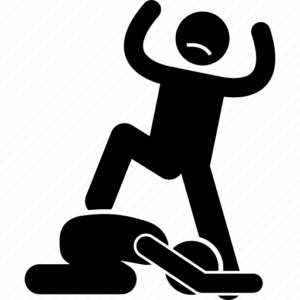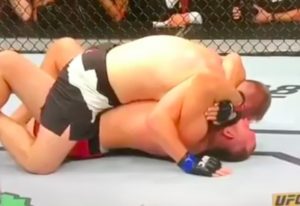by Ben Winn
Few things are binary, most exist on a spectrum, and nothing exists outside of context. To describe something as a “dominant position” implies that it is the position itself that is dominant. However, it is more accurate to say that the spectrum of dominance exists in the context of positioning. At its most pure, domination requires two participants, one occupying each of the extreme ends of the spectrum. In reality, the participants are both sliding back and forth along this spectrum, both dominating and being dominated in different ways. This struggle plays out through body positioning and culminates in submission. When viewing this struggle from the outside, body positioning becomes a generally reliable method of determining who is doing better at imposing their will on their opponent. This shorthand is why we refer to the positions as being dominant.
However, this relies on all of the possible variables in this equation being equal. Determining this equality is difficult at best as they include both the observable, such as weight and skill and the unobservable, like how rested the players are. As the inequality between these variables grows the effectiveness of this shorthand diminishes. Few people are going to argue that a 110 lbs person sitting on the chest of a 275 lbs bodybuilder is really dominating that situation.
Just as few would argue that a 145 lbs white belt mounted on a 145 lbs black belt is really dominating that situation. In either case, the person on bottom is going to stand up whenever they want to. If you mount a 145 lbs blue belt on another 145 lbs blue belt, then it becomes harder to say with any certainty that the player on bottom is going to stand up at will. That is starting to sound like a contest… a sport even.
So, what does it mean to dominate in the context of a combat sport? It is the ability to dictate where, when, and how your opponent moves that provides you with better opportunities for offense. This explains why the unequally stronger or more skilled person isn’t being dominated despite their bottom position but the equally matched players may be said to have a dominant position. All things being equal, the shorthand of positioning correlating to domination is most reliable. In sport BJJ there are (3) three primary dominant positions: Side Control, Mount, and Rear Mount, and their myriad of subsets. These are positions in which the geometry of their structure is designed to exploit anatomical weaknesses, like range of motion and the need for oxygen, to limit the other player’s options.
I’ve been very deliberate to refer to sport Jiu Jitsu to this point because perhaps one of the most interesting things about the Art of Brazilian Jiu Jitsu is how its philosophy can contradict this narrative. The closed guard is a case study of this. The hallmark position of the art, the closed guard, is not awarded points in sport BJJ the way that the dominant positions are. It is considered a neutral position, yet it is the person on the bottom who has a greater ability to attack while limiting their opponent’s ability to move. This is why Brazilian Jiu Jitsu as an art is so effective. It flips the traditional narrative of domination on its head. Every other grappling art tells you to stay off your back because it is a losing position from which you will be dominated. BJJ embraces it and makes what other arts see as a weakness into a strength. That is what this art is about; finding and exploiting the weaknesses in a strong position, attacking from the flank instead of head-on so that a less powerful force is amplified through the weaknesses of their target. Domination through efficiency, technique over strength.
Despite the mechanical advantages of a dominant position, nothing is perfect and it too has weaknesses. This is what makes Jiu Jitsu a potentially limitless chess game, there is a counter to everything if you just know how to look for them. To continue with the analogy, a player must make multiple mistakes before being submitted or brought to checkmate. The black belt who is mounted by a white belt understands where the weaknesses in the position are so that they can escape better than the white belt can capitalize on the strength of the mounted position.
If every position has its weakness then we can also conclude that every position has its strengths. Examining a basic mount we see that the top player has the advantage of gravity and the use of their torso to pin the bottom player (hence the reference to top and bottom positions) which frees the top player’s arms for attacks. However, this leaves the top player vulnerable to being off-balanced as they are sitting over the bottom player’s hips, the point that gets the most vertical thrust from a bridging motion. To accommodate for this the top player must either slide down to a low mount and grapevine the legs, which increases their control but limits their ability to attack or slide up into a high mount which is better offensively but gives up control of the bottom player’s hips. For their part, the bottom player can take advantage of the lack of offense from the low mount or their relatively increased mobility from a high mount to focus on escaping. Regardless of which mount, we have all experienced the frustration of struggling to gain this dominant position only to have it slip through our fingers like water because we shifted our weight the wrong way or fell victim to the fact that there is an object between us and the floor and it moved. They found the weakness in our position, or we created one, and they exploited it.
Anyone who has rolled with an upper belt as a lower belt has experienced that moment where they just walked around their opponent’s guard and thought, “I’ve got a bad feeling about this…”. That’s because Admiral Ackbar is about to pop up and yell “It’s a Trap!”. The upper belt is letting the lower belt take the dominant position so that they can explore the weaknesses of that dominant position even further. This gives them the ability to feel firsthand where the weaknesses are so they are not only better at exploiting them from the bottom but reinforcing them from the top.
This is why it is really important to play from the bottom even when working on top positions. There’s also a reason that it is typically upper belts that do this instead of lower belts. You have to understand the attack before you can defend against it, in this case, you have to understand how the player in the top position is trying to control you before you can understand how to deny them those things. Once a student has this basic understanding they can begin to refine it by examining it through different lenses to gain a deeper and more holistic understanding of it… or you can learn it like a lot of the older black belts did and have it smashed into you until you either figured it or you quit… a lot of people quit. It wasn’t fun that way… there is probably something wrong with us.
In conclusion, don’t take that dominant position for granted. Spend time becoming familiar with both sides of the position, they both have things to teach you. It might seem unpleasant but if you are going to spend time exploring the bottom side of dominant positions the best possible place to do that is in class, with your friends and training partners who are going to respect the tap rather than on the floor of a bar with someone who is probably trying to kill you. On that note, be willing to tap. We come to the gym to explore and to learn these dangerous things safely. If you aren’t getting tapped out then you probably aren’t exploring the limits of the position, especially as a lower belt. Get comfortable being on the bottom, the more comfortable you are there, the more dominant your position will be on top.


